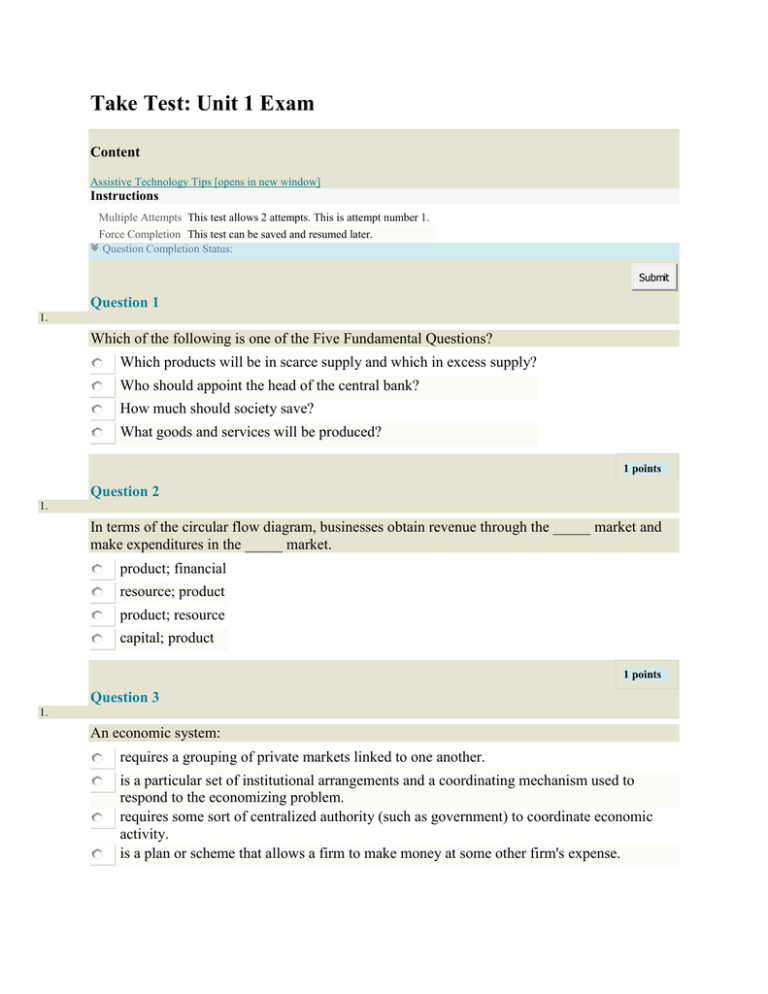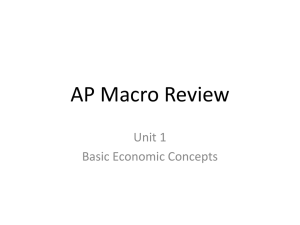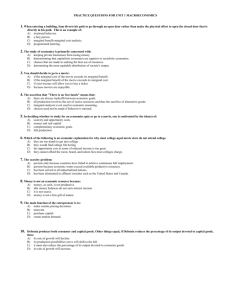1 points - Homework Market
advertisement

Take Test: Unit 1 Exam Content Assistive Technology Tips [opens in new window] Instructions Multiple Attempts This test allows 2 attempts. This is attempt number 1. Force Completion This test can be saved and resumed later. Question Completion Status: Submit Question 1 1. Which of the following is one of the Five Fundamental Questions? Which products will be in scarce supply and which in excess supply? Who should appoint the head of the central bank? How much should society save? What goods and services will be produced? 1 points Question 2 1. In terms of the circular flow diagram, businesses obtain revenue through the _____ market and make expenditures in the _____ market. product; financial resource; product product; resource capital; product 1 points Question 3 1. An economic system: requires a grouping of private markets linked to one another. is a particular set of institutional arrangements and a coordinating mechanism used to respond to the economizing problem. requires some sort of centralized authority (such as government) to coordinate economic activity. is a plan or scheme that allows a firm to make money at some other firm's expense. 1 points Question 4 1. Economic systems differ according to which two main characteristics? Who owns the factors of production, and the methods used to coordinate economic activity. The technology used in production, and the quantity and quality of natural resources. How goods are produced, and who gets them. The political system in place, and the degree of scarcity facing the economy. 1 points Question 5 Which of the following is assumed in constructing a typical production possibilities curve? the economy is using its resources inefficiently. resources are perfectly shiftable among alternative uses. production technology is fixed. the economy is engaging in international trade. 1 points Question 6 1. The typical production possibilities curve is: an upsloping line that is bowed out from the origin. a downsloping line that is bowed in toward the origin. a downsloping line that is bowed out from the origin. a straight upsloping line. 1 points Question 7 1. Broadly defined, competition involves: private property and freedom of expression. independently acting buyers and sellers and freedom to enter or leave markets. increasing opportunity costs and diminishing marginal utility. capital goods and division of labor. 1 points Question 8 1. Refer to the above diagram. Arrows (1) and (2) represent: goods and resources respectively. money incomes and output respectively. output and money incomes respectively. resources and goods respectively. 1 points Question 9 1. Which of the following is not considered by economists to be an economic resource? money factory workers computers at a retail store a forest 1 points Question 10 1. Slopes of lines are especially important in economics because: they measure marginal changes. they always tell us something about profits. positive slopes are always preferred to negative slopes. they always relate to resource and output scarcity. 1 points Question 11 1. Which of the following would not be classified as an economic resource by economists? a professional soccer player water in a town's reservoir money in a business checking account the manager of the local hamburger restaurant 1 points Question 12 1. The optimal point on a production possibilities curve is achieved where: the smallest physical amounts of inputs are used to produce each good. each good is produced at a level where marginal benefits equal marginal costs. large amounts of capital goods are produced relative to consumer goods. large amounts of consumer goods are produced relative to capital goods. 1 points Question 13 1. The problems of aggregate inflation and unemployment are: major topics of macroeconomics. not relevant to the U.S. economy. major topics of microeconomics. peculiar to command economies. 1 points Question 14 1. (Consider This) A direct cost of going to college is: tuition, while an indirect cost (opportunity cost) is books and other supplies. forgone income while in college, while an indirect cost (opportunity cost) is tuition. tuition, while an indirect cost (opportunity cost) is forgone income while in college. books and supplies, while an indirect cost (opportunity cost) is food and housing. 1 points Question 15 1. If products were in short or surplus supply in the Soviet Union: price and profit signals eliminated those shortages and surpluses. price and profit signals intensified those shortages and surpluses. producers would not react because no price or profit signals occurred. the planners would immediately adjust production to achieve equilibrium. 1 points Question 16 1. The optimal allocation of resources is found: where MB = MC. at every point along a production possibilities curve. where the marginal benefit is at its greatest. where the marginal cost is at its lowest. 1 points Question 17 1. (Consider This) Since World War II: North Korea's command economy has significantly outperformed South Korea's market economy. South Korea's command economy has significantly outperformed North Korea's market economy. North Korea's market economy has significantly outperformed South Korea's command economy. South Korea's market economy has significantly outperformed North Korea's command economy. 1 points Question 18 1. Command systems are also known as: market systems. pure capitalism. laissez-faire capitalism. communism. 1 points Question 19 1. The construction of a production possibilities curve assumes: the quantities of all resources are unlimited. technology is fixed. some resources are unemployed. there is no inflation in the economy. 1 points Question 20 1. Which of the following best describes the invisible-hand concept? The desires of resource suppliers and producers to further their own self-interest will automatically further the public interest. The non-substitutability of resources creates a conflict between private and public interests and calls for government intervention. The market system is the best system for overcoming the scarce resources-unlimited wants problem. Central direction by the government will improve resource allocation in a capitalistic economy. 1 points Question 21 1. The production possibilities curve has: a positive slope that increases as we move along it from left to right. a negative slope that increases as we move along it from left to right. a negative slope that decreases as we move along it from left to right. a negative slope that is constant as we move along it from left to right. 1 points Question 22 1. Households and businesses are: both buyers in the resource market. both sellers in the product market. sellers in the resource and product markets respectively. sellers in the product and resource markets respectively. 1 points Question 23 1. If we say that two variables are inversely related, this means that: the two graph as an upsloping line. an increase in one variable is associated with a decrease in the other. an increase in one variable is associated with an increase in the other. the resulting relationship can be portrayed by a straight line parallel to the horizontal axis. 1 points Question 24 1. The process of producing and accumulating capital goods is called: money capital. depreciation. investment. consumption. 1 points Question 25 1. In the simple circular flow model: households are buyers of resources. businesses are sellers of final products. households are sellers of final products. there are real flows of goods, services, and resources, but not money flows. 1 points Question 26 1. A country can achieve some combination of goods outside its production possibilities curve by: idling some of its resources. specializing and engaging in international trade. buying the debt (bonds and stocks) of foreign nations. producing more capital goods and fewer consumer goods. 1 points Question 27 1. The French term "laissez-faire" means: "there is no free lunch." "let it be." "circular flow." "public ownership." 1 points Question 28 1. The alternative combinations of two goods which a consumer can purchase with a given money income is shown by: a production possibilities curve. a demand curve. consumer expenditure line. a budget line. 1 points Question 29 1. Which of the following is a distinguishing feature of a command system? private ownership of all capital. central planning. heavy reliance on markets. wide-spread dispersion of economic power. 1 points Question 30 1. The dollar votes of consumers ultimately determine the composition of output and the allocation of resources in a market economy. This statement best describes the concept of: derived demand. consumer sovereignty. the invisible hand. market failure. 1 points Question 31 1. The main function of the entrepreneur is to: make routine pricing decisions. innovate. purchase capital. create market demand. 1 points Question 32 1. For economists, the word "utility" means: versatility and flexibility. rationality. pleasure or satisfaction. purposefulness. 1 points Question 33 1. Economic theories: are useless because they are not based on laboratory experimentation. that are true for individual economic units are never true for the economy as a whole. are generalizations based on a careful observation of facts. are abstractions and therefore of no application to real situations. 1 Question 34 1. Which of the following statements is true? Microeconomics focuses on specific decision-making units of the economy; macroeconomics examines the economy as a whole. Macroeconomics focuses on specific decision-making units of the economy; microeconomics examines the economy as a whole. Every topic in economics is either a microeconomic or a macroeconomic issue; a topic cannot be both. Topics in microeconomics have public policy implications; topics in macroeconomics do not. 1 Question 35 1. (Last Word) The fallacy of composition states that: because economic systems are composed of so many diverse economic units, economic laws are necessarily inexact. the anticipation of a particular event can affect the composition of that event when it occurs. what is true for the individual must necessarily be true for the group. because event A precedes event B, A is necessarily the cause of B. 1 points Question 36 1. Which of the following is a fundamental characteristic of the market system? property rights. central planning by government. unselfish behavior. government-set wages and prices. 1 points Question 37 1. The production possibilities curve: shows all of those levels of production that are consistent with a stable price level. indicates that any combination of goods lying outside the curve is economically inefficient. is a frontier between all combinations of two goods that can be produced and those combinations that cannot be produced. shows all of those combinations of two goods that are most preferred by society. 1 points Question 38 1. The slope of a budget line reflects the: desirability of the two products. price ratio of the two products. amount of the consumer's income. utility ratio of the two products. 1 points Question 39 1. The two basic markets shown by the simple circular flow model are: capital goods and consumer goods. free and controlled. product and resource. household and business. 1 points Question 40 1. Which of the following is not a characteristic of the market system? private property. freedom of enterprise. government ownership of major industries. competition in product and resource markets. 1 points Question 41 1. The economizing problem is: the need to make choices because economic wants exceed economic means. how to distribute resources equally amongst all members of society. that people's means often exceed their wants. that people do not know how to rationally allocate resources. 1 points Question 42 1. Which of the following is a distinguishing feature of a market system? public ownership of all capital. central planning. wide-spread private ownership of capital. a circular flow of goods, resources, and money. 1 points Question 43 1. (Consider This) North Korea's command economy: is one of the few remaining command economies. has grown much faster than South Korea since the two countries were divided after World War II. produces a per capita GDP of nearly $25,000. has undergone significant market reforms and is now one of the fastest growing economies. 1 points Question 44 1. Macroeconomics can best be described as the: analysis of how a consumer tries to spend income. study of the large aggregates of the economy or the economy as a whole. analysis of how firms attempt to maximize their profits. study of how supply and demand determine prices in individual markets. 1 points Question 45 1. Purposeful behavior means that: people are selfish in their decision-making. people weigh costs and benefits to make decisions. people are immune from emotions affecting their decisions. decision-makers do not make mistakes when weighing costs and benefits. 1 points Question 46 1. The division of labor means that: labor markets are geographically segmented. unskilled workers outnumber skilled workers. workers specialize in various production tasks. each worker performs a large number of tasks. 1 points Question 47 1. The point on the production possibilities curve that is most desirable can be found by: estimating the marginal costs of both products in real or physical terms. comparing marginal benefits and marginal costs. determining where least-cost production occurs. calculating where economic growth will be greatest. 1 points Question 48 1. The most efficient combination of resources in producing a given output is the combination that: comes closest to using the same quantities of land, labor, capital, and entrepreneurial ability. can be obtained for the smallest money outlay. uses the smallest total quantity of all resources. conserves most on the use of labor. 1 points Question 49 1. Refer to the above diagram. Arrows (3) and (4) represent: goods and services respectively. incomes and consumer expenditures respectively. resources and goods respectively. consumer expenditures and income respectively. 1 points Question 50 1. Which of the following terms implies the least degree of confidence in an economic generalization? a hypothesis. a theory. a principle. a law.








